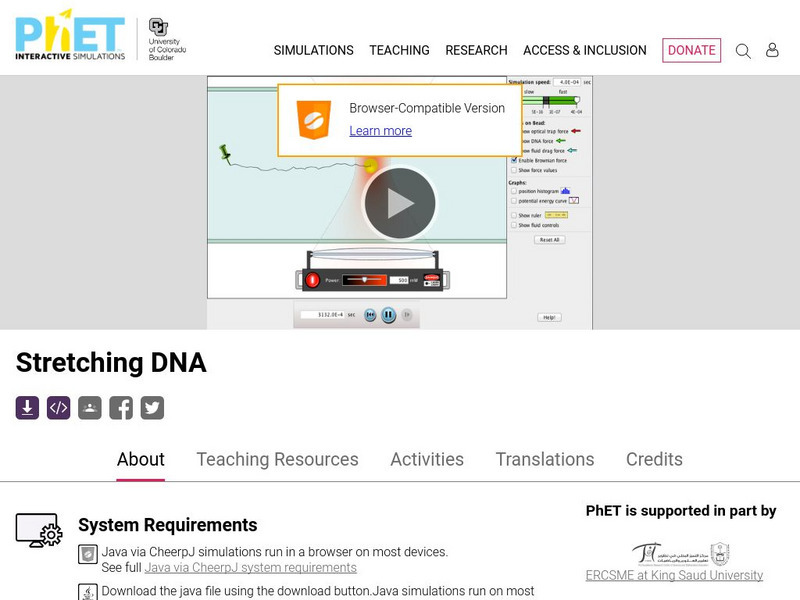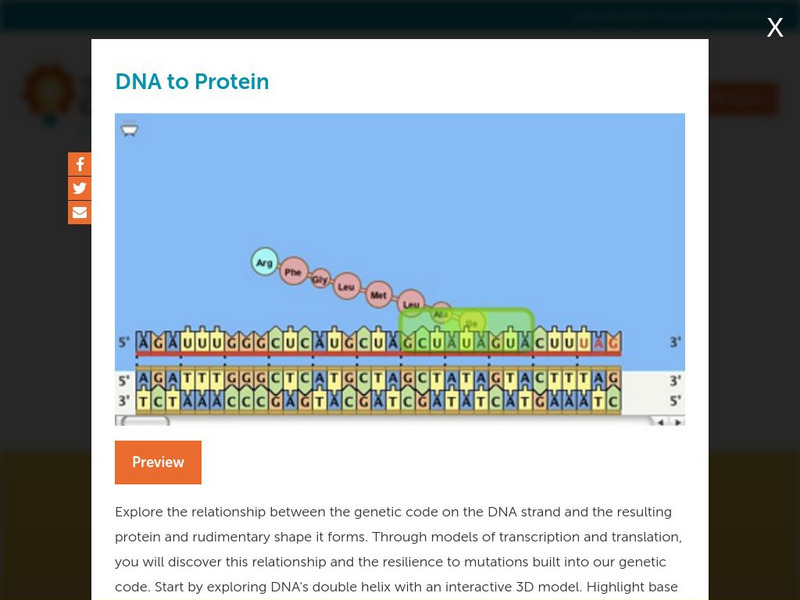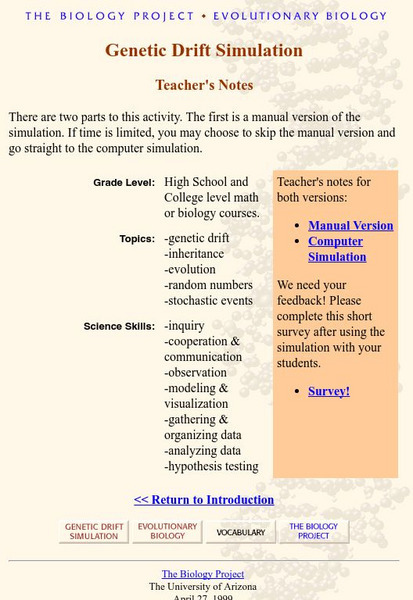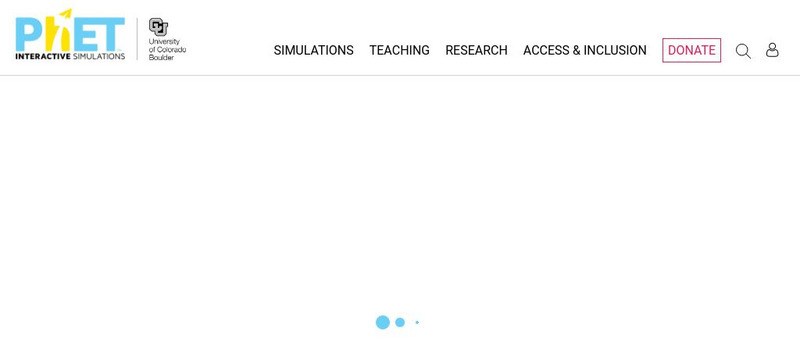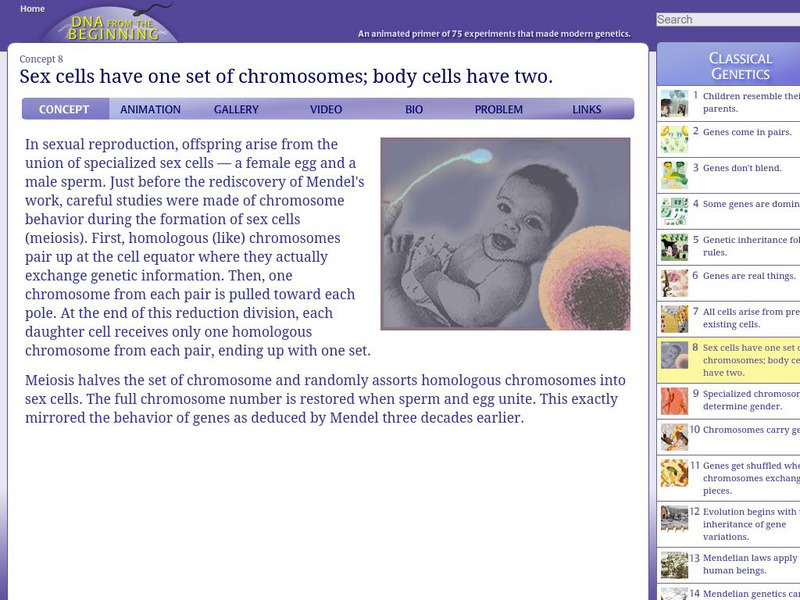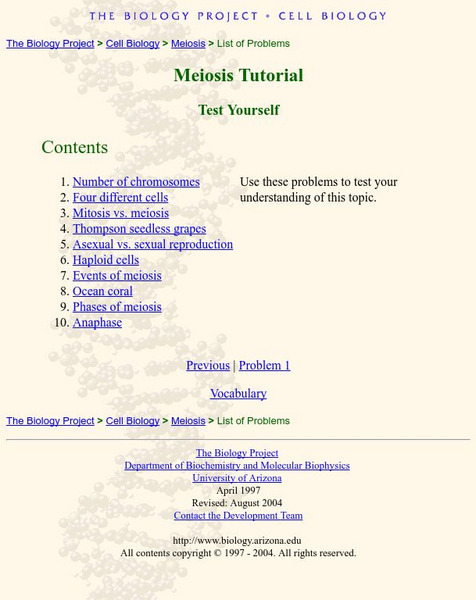National Health Museum
Access Excellence: Wolf Pack in a Bottle: Dna Simulation
This lesson plan can be used to illustrate the principle of electrophoresis without the equipment. Paper chromatography can be used to separate dye just like electrophoresis will separate DNA. The lab also covers DNA analysis for an...
University of Colorado
University of Colorado: Ph Et Interactive Simulations: Stretching Dna
Explore stretching just a single strand of DNA using optical tweezers or fluid flow. Experiment with the forces involved and measure the relationship between the stretched DNA length and the force required to keep it stretched.
Concord Consortium
Concord Consortium: Stem Resources: Dna to Protein
Investigate how the genetic code on a DNA strands controls what protein is produced with this collection of animations and 3D models. Explore an interactive 3D model of the double helix, watch an animation of transcription, and see the...
University of Arizona
University of Arizona: Genetic Drift Simulation
This site from the University of Arizona runs a two-step simulation of Genetic Drift. There are teacher's notes included. A great site to aid in understanding Genetic Drift.
Carnegie Mellon University
Chem Collective: Dna Binding Dyes Scenario
This activity explores the equilibrium of dyes that self-assemble into DNA templates. Students use knowledge of equilibrium and quantitative spectroscopy to explore different dyes that bind selectively to DNA molecules. In this activity,...
Concord Consortium
Concord Consortium: Molecular Workbench: Modeling Dna Hybridization
View this simulation of DNA Hybridization.
University of Colorado
University of Colorado: Ph Et Interactive Simulations: Gene Machine: The Lac Operon
Build a gene network. The lac operon is a set of genes which are responsible for the metabolism of lactose in some bacterial cells. Explore the effects of mutations within the lac operon by adding or removing genes from the DNA.
John Wiley & Sons
Wiley: Animations: Essential Biochemistry: Dna Replication
Enter the DNA factory to simulate the process of DNA replication. After each step of the progression, take a quick quiz before moving on.
Concord Consortium
The Concord Consortium: Molecular Workbench: Dna Polymerase
Observe the animated model to see DNA being replicated.
University of Colorado
University of Colorado: Ph Et Interactive Simulations: Gene Expression the Basics
Generate and collect three types of proteins, then move on to explore the factors that affect protein synthesis in a cell.
Cold Spring Harbor Laboratory
Dna From the Beginning: Theodore Boveri's Discovery of Meiosis
Theodore Boveri will describe his research with worms that helped him discover the principles of meiosis. The animations of meiosis are really good.
National Health Museum
Access Excellence: Making a Phylogenetic Tree Lesson Plan
Constructing phylogenetic trees may be a daunting task for students, but this lesson plan is a simulation of what molecular biologists must do to determine relationships. This plan is for students who have a good grasp of DNA structure...
Concord Consortium
Concord Consortium: Molecular Workbench Showcase: Biotech
Simulations of common biotechnology techniques performed in a laboratory setting. Learn how to complete these techniques and what task they are used for in the lab.
University of Utah
University of Utah: Learn Genetics: Gel Electrophoresis
Simulate the process of gel electrophoresis with this interactive animation. It's a rather detailed and engaging activity.
Concord Consortium
Concord Consortium: Stem Resources: Intermolecular Attractions
Learn that boiling point, solubility, and DNA are affect by intermolecular forces in this module. Module includes lessons with questions and animations to explain London dispersion and dipole-dipole attractions. To conclude the lessons,...
Oklahoma State University
Oklahoma State University: Ag in the Classroom: Hairy Heredity [Pdf]
A simulation where students flip coins to mimic how parents pass genetic traits to their offspring through heredity. This activity also illustrates the difference between dominant and recessive genes, and how they interact with each...
Concord Consortium
Concord Consortium: Science of Atoms and Molecules: Nucleic Acids and Proteins
Through this activity, learners work with macromolecules, proteins and nucleic acids. The focus is on the atomic structure of proteins, how linear polymers are made, and the surface charges of the resulting polymers. . Multiple-choice...

